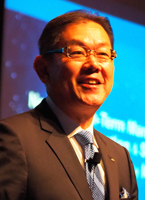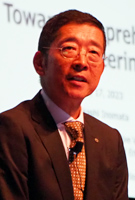Suggesting IOWN’s next move Tsukuba Forum 2023 Keynote Speech
Tsukuba Forum 2023 was held at NTT Access Network Service Systems Laboratories (Tsukuba City, Ibaraki Prefecture) for two days, 17th (Wednesday) and 18th (Thursday). At the keynote speech, NTT Executive Vice President Takehiko Kawazoe took the podium and talked about “Towards NTT to create new value and support a global sustainable society.” Takashi Inomata, Managing Director of NTT West, introduced the company’s efforts under the title of “Towards Comprehensive Engineering.” Summarize part of the lecture.
Lecture by Vice President Kawazoe

IOWN2.0 is involved in two areas: networking and computing.
IOWN 1.0’s network services are limited to the same area, but 2.0 will expand this even further. The most important point of IOWN is to reduce power consumption, and we would like to implement it in the form of Step 2 of IOWN. 13 times reduction in terms of power efficiency. Ultimately, we aim to increase power efficiency by 100 times.
Step 2 will be after 2012, but we will connect major cities and have more people use it. Furthermore, from fiscal 2014 onwards, we plan to provide it on a business basis wherever it is needed throughout Japan.
We would like to introduce a multistage loop optical access network as a new technology related to IOWN. It’s a good idea to configure the network in a loop to make the access part more reliable.
For example, connecting with a loop, including the core network of 6G base stations, will greatly increase reliability. The timing of introduction has not been decided, but the current situation is under review.
IOWN is originally high in performance and reliability, but it must be made more robust.
One is to drastically reduce human error. We will also introduce various technologies to prevent failures from occurring. At the same time, when a failure occurs, we will also respond to a mechanism that minimizes the scope of impact as much as possible.
To that end, we will invest approximately 160 billion yen by FY2013.
For computers, the point is optoelectronic convergence technology, which is representative of IOWN technology. The conversion of light to electricity and electricity to light, this is the part where power efficiency can be improved the most, and is the key to performance.
In IOWN 2.0, conversion points from light to electricity and from electricity to light come to the board. IOWN 1.0 includes servers and data centers, but IOWN 2.0 goes further inside. Since the light comes close to the board, the power consumption of the LSI can be reduced.
In IOWN 3.0, an optoelectronic device is introduced for connection between chips, so LSI chips on the same substrate are optically connected. This further increases power efficiency.
The final IOWN4.0 optically connects the modules in the chip. It is made in the form of an optical waveguide. If we can do this, the power efficiency will be 100 times higher than before.
Lecture record of Managing Director Inomata

How will NTT East and West transform into a comprehensive engineering company? Not only digital sharing, but also DX promotion, and NTT’s unique digital citizenship. How would you describe your worldview? I think it’s important to show the difference rather than the better.
Digital sharing is currently underway. Introduced “Field Assistant” as a digitalization of on-site operations. On-site technicians may gather in places they have never been before, such as for disaster recovery support. The key to such technical support is visualization on a map. In the event of an emergency, you can see who is near the location on the map, and assign that person to rush to the location. Field assistants are used here as well. In addition, as skill management, we are developing total assignments using field assistants as a hub, such as visualizing and assigning employees’ experience and qualifications.
Field assistants have been introduced by NTT East Japan and telecommunications construction companies. NTT West would like to offer this service to other customers as well. We believe that small and medium-sized enterprises, local governments, hospitals, home delivery companies, and other customers who have on-site locations will use the service, but progress is slow. It’s because we haven’t reached digital citizenship yet. Because the customer is also doing DX and has a similar system. On the other hand, the API of the business chat “elgana” provided by the NTT group can be used for hub cooperation. We believe that with elgana as a hub, we can gain digital citizenship.
As for IOWN, I have high hopes for the 4D digital platform that lies ahead of IOWN. The 4D digital platform incorporates not only latitude, longitude, and height, but also a time axis. In other words, information can be linked in four dimensions.
We are currently acquiring regional spatial data. Furthermore, if we collect data on the flow of people, we will be able to use the 4D digital platform as a platform to conduct various simulations. Coordinated maintenance of social infrastructure will become possible, and in addition to that, we believe that it can also be used for roads, rectification of traffic, utilization of urban assets, environment and disaster prevention.
